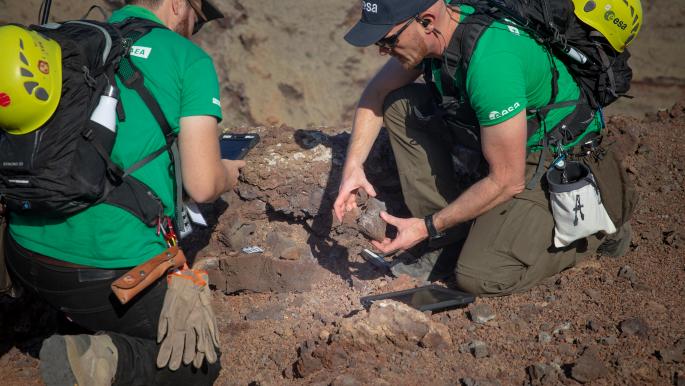Uses Astronaut Alexander Gerst extracts a sample of volcanic rock with a chisel and carefully places it inside a white plastic bag. The surface of the moon“.
But the 46-year-old German astronaut and member of the European Space Agencyis still on the ground, especially in Los Volcanes Natural Park in Lanzarote, one of Canary Islands Spanish off the northwest coast of Africa.
The geology of Lanzarote, with its black lava fields and volcanic flows, is so similar to the nature of the Moon and Mars that the European Space Agency and the US Space Agency (NASA) have sent astronauts to this island to the training.
“This place has lava, very similar to what we find on the surface of the moon,” the astronaut told AFP. She added that the island was a “unique training ground”.
Gerst, who has completed two missions to the International Space Station, is one of about a dozen astronauts who have taken part in the European Space Agency’s Pangea course in Lanzarote over the past decade.
Named after the ancient supercontinent, Pangea seeks to equip astronauts, space engineers and geologists with the skills to go on missions to other planets.
Trainees learn how to identify and collect rock samples, conduct in situ DNA analyzes of microorganisms, and report their findings to mission control.
“Here they are fielded to experiment with terrain exploration, something they are supposed to do on the moon,” said Francesco Sauro, technical director of the course.
The largest volcanic disaster
Gerst said the Pangea course, which he just completed, helps prepare astronauts to work away on their own. “If we encounter a problem, we have to solve it ourselves,” she explained.
Gerst completed his course with Stephanie Wilson, one of NASA’s senior astronauts. Both are potential candidates for NASA manned missions to the moon.
NASA’s Artemis program aims to return astronauts to the lunar surface as early as 2025, though many experts believe that timeframe could be longer.
Twelve astronauts walked on the moon during 6 Apollo missions between 1969 and 1972. Returning to the moon is a necessity before a possible trip to Mars.
Additionally, US and European space agencies are using the geography of Lanzarote to test remote-controlled Martian rovers designed to travel to the surface of the Red Planet.
Lanzarote’s unique geography dates back to a volcanic eruption that started in 1730 and lasted for 6 years, spewing ash and lava over large areas of land.
This volcanic catastrophe, considered one of the largest in history, destroyed more than 200 square kilometers of land, about a quarter of the area of the island, where some 156,000 people currently live.
Desert climate
Although there are other volcanic regions that can also be used to train astronauts, Lanzarote has the advantage of having little vegetation due to its desert climate.
“There are many types of volcanic rock in Lanzarote. They are exposed. There are no trees,” said Loredana Bisoni, Pangea project manager.
The Canary Islands also make a significant contribution to space exploration in another way: Las Palmas is home to one of the largest optical telescopes in the world.
Sitting atop the Great Canary Telescope, it detects some of the faintest and most distant objects in the universe.
Las Palmas was chosen as the location for the telescope due to its cloudless skies and relatively low light pollution.
(AFP)


